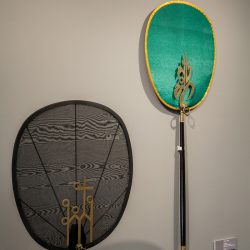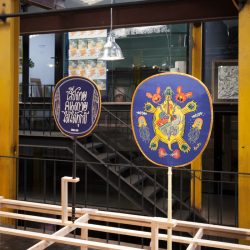CURATED BY HONGTAE, ‘FLIP THE FAN’ BRINGS TOGETHER VARIOUS ARTISTS TO CREATE ART PIECES ON ‘TALAPAT’
Most Thai people are familiar with the meaning of the expression ‘Glub Talapat’ (flip the fan) as much as they are able to identify the object known as a ‘Talapat.’ But if we were to further explore what the object really is from its functionality and role in Buddhist ceremonies to the tradition and norm behind the evolution of its design, the answer may not be as clear as one had hoped. The general knowledge of Talapat or talipot fan is that it is a fan-like tool Buddhist monks put in front of their faces when they pray that has embroidered details that are highly traditional, ranging from the symbols of the Royal Family’s members to logos of temples. Some contain stories related to Buddhist philosophy and teachings such as the words ‘Born, Grow Old, Get Sick and Die’ or ‘Forever Departed, Infinite Rest, No Return, Inescapable.’
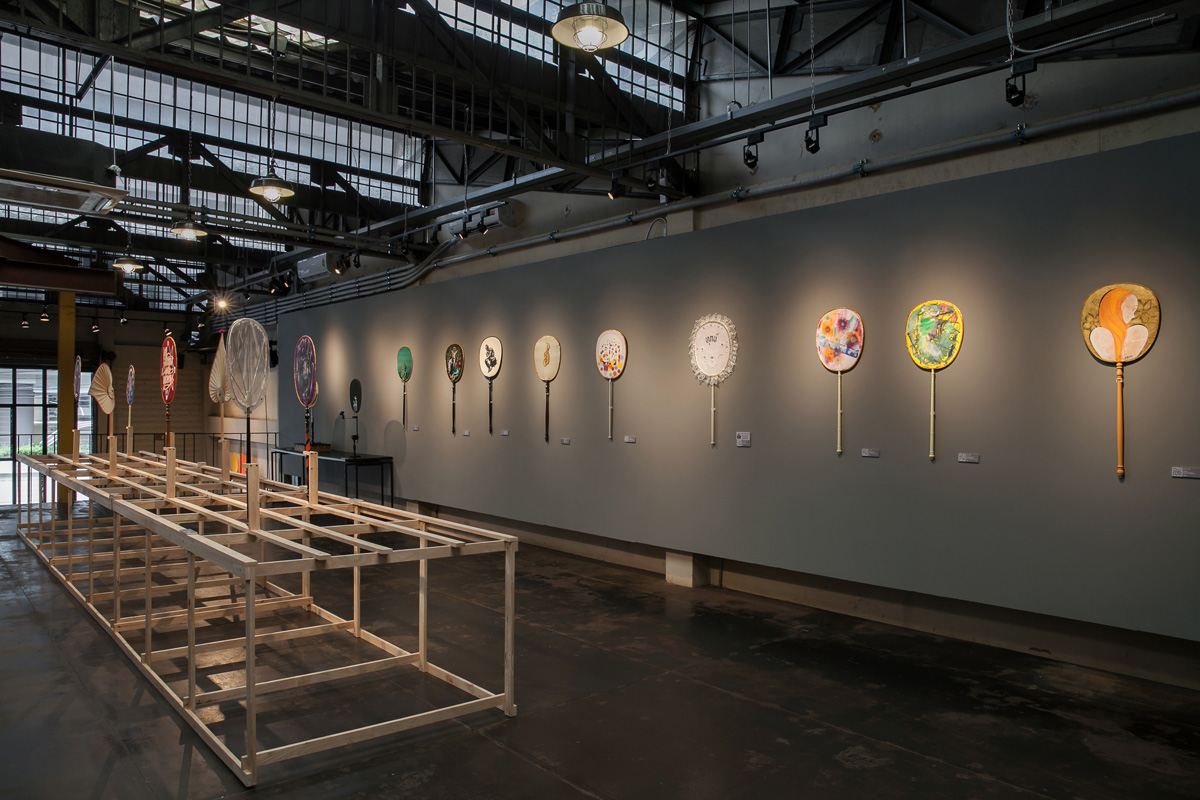
Those who are keen followers of art history might be familiar with the vivid graphics of Prince Chitcharoen, the Prince Narisara Nuvattivongse’s design while the Talapat with the famous character Mr. Hell Yeah! specifically designed by Slowmotion Studio for the funeral of the late Pharuephon Mukdasanit (Mamafaka) is still in the memory of the street art enthusiasts. Such obscured diversity is why we are particularly interested in the group exhibition, ‘Flip the Fan,’ that has Hongtae or Konthorn Taecholarn as its curator with 10 artists/designers invited to express their artistic interpretations utilizing ‘Talapat’ as the medium.
Within the gallery space of YELO House is where we begin to readjust our understanding about the object through an introductory video of the exhibition where artists talk about Talapat from their own points of view. The curator then reveals that the root of the word ‘Talapat’ can be simply translated to a ‘palm leaf fan’—nothing more. But with the role of the fan in religious ceremonies, Thai society has gradually formulated and paired unquestioned spiritual meanings with Talapat. But once the embellished perceptions are eliminated, new artistic possibilities emerge and call upon the use of the fabric of Talapat as a new canvas.
As a result, the works showcased in the exhibition are incredibly diverse. Some of the artists created more than one piece proposing new possibilities for the object known as Talapat with different degrees of creativity and functionality that are free from all institutional constraints. The focus is put on the object’s straightforward functionalities, from the installation of a built-in microphone that offers functional convenience for the monks to the more contemporary presentation of teachings and words of wisdom. While some of the works still follow Buddhist conventions, there are a number of works that incorporate elements from different religions and cultures, or even the use of projection mapping to show the connection between the two sides of Buddhist teachings. The presence of a QR code on each of the works reaffirms the exhibition’s attempt to eliminate the preconceived notions and somewhat untouchable status of Talapat. Each code links to a video clip with the artist who created the fan explaining the concept behind each work.
Having seen all the exhibited works, what stood out the most seems to be the simple, unembellished Talapat—the palm leaf fan that is the origin of it all. The entire process of the exhibition achieves what it intended to do, for it gets viewers to question irrational beliefs and look for new possibilities of artistic expression, which is something that can be applied to many other issues in our society.
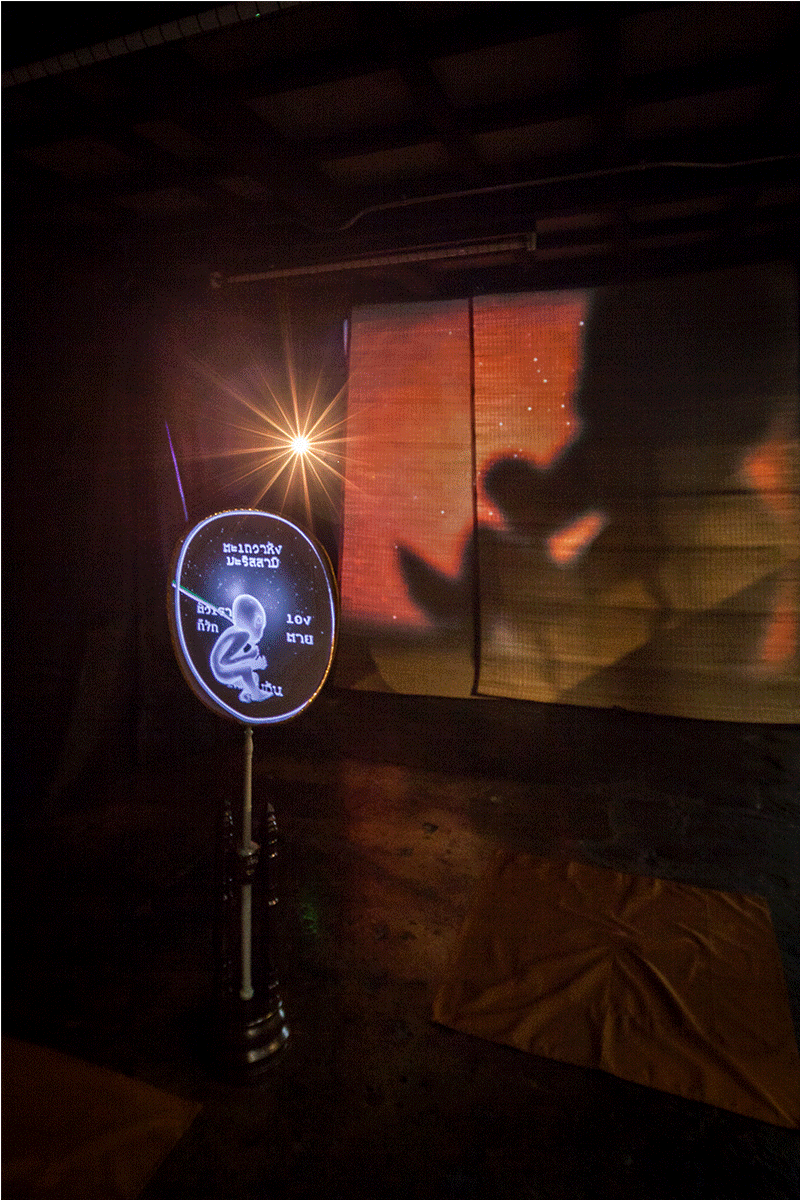
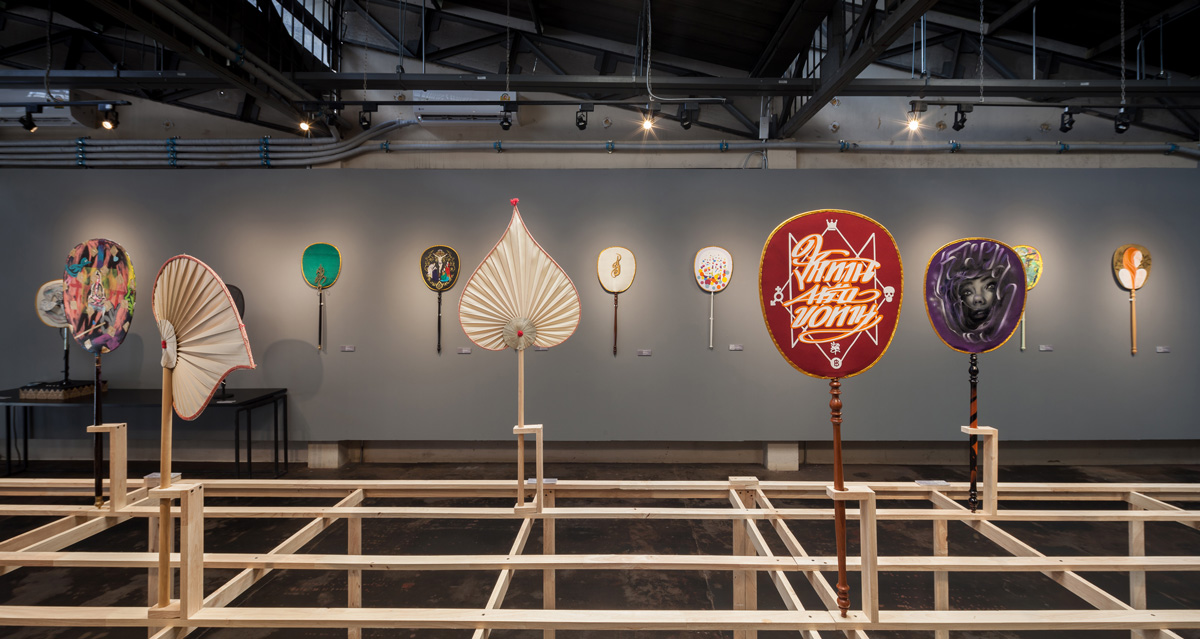
เราเชื่อว่าทุกคนเคยได้ยินและเข้าใจความหมายของสำนวนไทย “กลับตาลปัตร” และรู้ว่า “ตาลปัตร” คือวัตถุชิ้นใด แต่ถ้าจะถามลึกลงไปว่าตาลปัตรคืออะไร? มีประโยชน์ใช้สอยอย่างไร? มีหน้าที่อย่างไรในพิธีกรรมทางพุทธศาสนา? และมีธรรมเนียมหรือแนวนิยมในการออกแบบเป็นอย่างไร? ก็อาจจะไม่ได้คำตอบที่ชัดเจนนัก เพราะจากการรับรู้ของบุคคลทั่วไป หลายคนจะมีภาพจำว่าตาลปัตรคือพัดที่พระสงฆ์จะนำมาบังหน้าในเวลาสวด มีลวดลายปักแบบอนุรักษ์นิยม บ้างก็เป็นตราสัญลักษณ์ของราชสำนักหรือวัดต้นสังกัด บ้างก็เป็นเรื่องราวเกี่ยวกับพุทธศาสนา เช่น ตัวอักษรคำว่า “เกิด แก่ เจ็บ ตาย” หรือ “ไปไม่กลับ หลับไม่ตื่น ฟื้นไม่มี หนีไม่พ้น” ในขณะที่ผู้สนใจประวัติศาสตร์ศิลปะอาจจะเห็นภาพของงานออกแบบลวดลายตาลปัตรที่มีลีลาความเป็นกราฟิกจัดจ้านของสมเด็จพระเจ้าบรมวงศ์เธอ เจ้าฟ้ากรมพระยานริศรานุวัดติวงศ์ หรือในความทรงจำของคนรุ่นใหม่ที่สนใจ street art ก็อาจจะมีภาพตาลปัตร Mr. Hell Yeah! ในงานศพของ ตั้ม-พฤษ์พล มุกดาสนิท (Mamafaka) ที่ออกแบบโดยสตูดิโอ Slowmotion ความหลากหลายอันคลุมเครือนี้เองที่ทำให้เราสนใจนิทรรศการกลุ่ม “กลับตาลปัตร” ที่ได้ ฮ่องเต้-กนต์ธร เตโชฬาร เป็นคิวเรเตอร์และได้ศิลปิน/นักออกแบบร่วมสมัยกว่า 10 ชีวิต มาสร้างงานศิลปะที่มีสื่อเป็นตาลปัตร
ในพื้นที่แกลเลอรี่ของ YELO House เราได้เริ่มต้นปรับความเข้าใจเพิ่มเติมเกี่ยวกับตาลปัตร ผ่านวิดีโอแนะนำนิทรรศการที่มีศิลปินออกมาพูดถึงความเข้าใจเกี่ยวกับตาลปัตรในมุมมองของตนเอง ก่อนที่คิวเรเตอร์จะออกมาเฉลยว่า “ตาลปัตร” ถ้าแปลตามรูปศัพท์ก็คือ “พัดใบลาน” ไม่ได้มีความหมายอะไรมากกว่านั้น แต่เมื่อมันถูกใช้ในพิธีกรรมทางศาสนา จึงทำให้สังคมไทยสร้างความศักดิ์สิทธิ์นี้ขึ้นมาครอบ และเสริมแต่งความหมายไปโดยไม่ตั้งคำถาม เมื่อเราถอดการรับรู้เหล่านั้นออกไปแล้วความเป็นไปได้ในการสร้างงานศิลปะบนแคนวาสที่อยู่ในรูปทรงของตาลปัตรจึงไม่มีข้อจำกัด
ผลงานที่จัดแสดงจึงมีความหลากหลายสูงมาก ศิลปินบางคนสร้างงานมามากกว่าหนึ่งชิ้น นำเสนอความเป็นไปได้ของวัตถุที่เรียกว่า “ตาลปัตร” ในดีกรีที่แตกต่างกันไป โดยไม่มีกำแพงของความศักดิ์สิทธิ์ ความเป็นวัด/วัง มาขัดขวาง ตั้งแต่การโฟกัสที่ประโยชน์ใช้สอยอย่างตรงไปตรงมา เช่น ติดไมโครโฟน built-in หรือพัดลม เพื่อมอบความสะดวกสบายให้แก่พระสงฆ์ การนำเสนอข้อคิดคำสอนก็มีทั้งการนำเนื้อหาที่คุ้นเคยมานำเสนอในรูปแบบที่ร่วมสมัยขึ้นตามสไตล์ของศิลปิน หรือนำเสนอข้อคิดใหม่ที่สอดคล้องกับบริบทของสังคมในปัจจุบันมากขึ้นโดยยังอยู่ในกรอบของพุทธ จนไปสุดทางถึงการนำองค์ประกอบจากศาสนาอื่นและวัฒนธรรมอื่นมาใช้ และยังมีผลงานที่ใช้ projection mapping แสดงให้เห็นความสัมพันธ์ระหว่างเบื้องหน้า/เบื้องหลังของคำสอนด้วย อีกจุดหนึ่งที่ตอกย้ำการทำลายภาพจำและความเชื่อเกี่ยวกับตาลปัตรและความเข้าถึงยากของงานศิลปะ คือการมี QR Code อยู่บนป้ายกำกับผลงานเกือบทุกชิ้น ที่ลิงค์ไปยังคลิปวิดีโอซึ่งศิลปินจะมาอธิบายแนวคิดในผลงานของตน
หลังจากได้ชมชิ้นงานทั้งหมดแล้ว สิ่งที่สะดุดตาเราที่สุดกลับเป็นตาลปัตรใบลานที่ดูสง่างามในความเรียบง่าย และปราศจากการปรุงแต่ง นี่อาจจะเป็นสิ่งที่มันเคยเป็นในตอนเริ่มต้น เรามองว่ากระบวนการทั้งหมดในนิทรรศการนี้ทำหน้าที่ได้หมดจดในการพาผู้ชมให้ตั้งคำถามกับความเชื่อที่ปราศจากเหตุผล และมองหาความเป็นไปได้ในการแสดงออกนี่คือสิ่งที่เราควรนำไปใช้กับประเด็นอื่นๆ ในสังคมของเรา
TEXT: WEE VIRAPORN
PHOTO: KETSIREE WONGWAN
yelohouse.com


